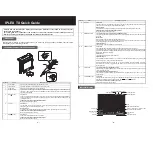
| 18
19 |
9.1 Notes for coating thickness measurement
To carry out the correct film thickness
measurements not only a proper handling of
the measuring instrument are an advantage, but
also a basic knowledge of general handling of
coating thickness gauges and the corresponding
metrological requirements.
This mainly concerns the following topics:
- Selecting the suitable measuring method
- Statistical evaluation methods of measurement
series
- Interpretation of measured values
We recommend in case of new (and random
sample-based) combinations of materials, to check
measured values of the PowderTAG against values
obtained by other layer thickness measurement
methods (such as a regular coating thickness
gauge). If necessary the PowderTAG values can be
corrected via a user calibration. (See section 10.3)
9.2 Preparation for measurement
Select the calibration that suits the measurement
task. Depending on the application, you can
select an existing factory calibration (powder,
powder thick, cured). Measurements with
maximum measuring accuracy can be achieved
with calibrations that have been created from the
combination of materials to be examined (see
Chapter 10).
When a second layer of coating is applied the
PowderTAG will add 25% of the layer thickness of
the first (cured) layer to the measured value of the
second layer. To calculate the actual layer thickness
of the second layer this 25% has to be substracted
from the measured value.
E.G.: the first layer (cured) is 100 µm. The PowderTAG
measures 85 µm on the second layer. Then the
actual thickness of the second layer is 60 µm. (25%
of 100 µm = 25 µm. 85µ - 25 µm = 60 µm)
9.3 Performing measurements
Freehand measurements
Photo-thermal measuring processes are non-
contact thus non-destructive.
While performing a freehand thickness
measurement it is important to keep the correct
working distance to the object. The LED-pointer
helps to achieve this. The pointer consists of three
on the sensor positioned LEDs. When the three LED
pointers combine into one point on the object the
correct distance is achieved and a measurement
can be performed.
Measurements with distance cap
Generally, the use of a distance cap (Art. No LD5852,
to be ordered separately) is recommended for
touch-sensitive materials. This makes it possible to
maintain an accurate working distance without the
risk of touching an object.
Measurements with Tripod
For the contactless measurement of small parts and
geometries, we recommend using a tripod.
10.1 General guide lines
Measure settings menu of the PowderTAG shows all
the Calibration options. Three factory calibrations
are available: Powder, Powder Thick and Cured.
It is possible to create user calibrations based on the
factory calibrations. The PowderTAG has the option
of single-point or two-point calibration.
To ensure an optimum calibration the following
should be observed:
The quality of a calibration influences how precisely
the layer thicknesses of a material system can
be determined. A careful approach is therefore
essential.
Please note that the powder coatings may vary
greatly in nature and composition. Since the color
in the photo-thermal layer thickness measurement
also plays an important role, under cer-tain
circumstances, despite calibration it occasionally
may come to unsatisfactory measurement results in
the color range of bright yellow, orange and red!
Calibration should be performed on a calibration
object. The material properties of this calibrati-on
object should match the material properties of the
object to be measured as closely as possible. The
better both objects match the better the calibration,
thus the accuracy of measurement.
The results of a film thickness measurement
only covers the measured positions of an object.
It is therefore important to ensure that the
measurement position matches the created
calibration and the measurement position of the
reference method. Moreover, it should in certain
circumstances be ensured (by means of statistical
methods), that the layer thickness information of
the reference measurement and the calibration
measurement are obtained from the same
measurement area. This is particularly important
with rough objects.
10.2 Factory calibrations
The PowderTAG has three factory calibrations
(powder, powder thick and cured)
Powder:
Measures the expected dry film thickness after cure
of powders with an expected dry film thickness
under 50 - 150 µm.
Powder thick:
Measures the expected dry film thickness after cure
of powders with an expected dry film thickness of
50 - 250 µm and up.
Cured:
Measures the dry film thickness after cure of 50 -150
µm.
The “Check Instrument” function in the “Instrument
Settings” menu is no calibration tool. It only checks
the UV-source (see section 8.5).
10.3 User calibration
The PowderTAG allows the use of up to 20
calibrations. You can create a new calibration by
selecting New Calibration (Measurement Settings>
User Calibration> New Calibration). In the field type
a factory calibration (powder, cured, powder thick)
suitable for the material system to be examined
can be selected. It contains basic information like
measuring times and measuring method. After
saving the new calibration, the menu for single-
point calibration or two-point calibration pops up.
This allows for rapid calibration.
10.4 Calibration methods
10.4.1 Single point calibration - Powder
After confirming Powder and single-point
calibration, you end up in the measured value recor-
ding of the calibration menu. Here you can make
measurements, and adjust the measurement value
manually.
9 MEASURING MODE
10 CALIBRATIONS
Summary of Contents for LD5860
Page 13: ...www tqcsheen com ...































